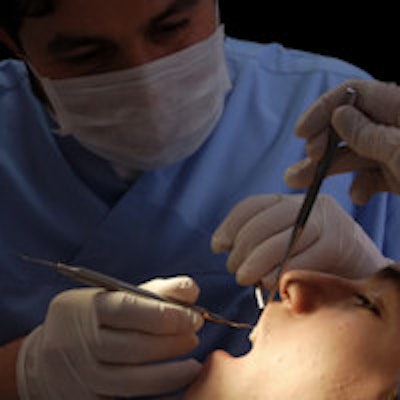
Researchers involved in the development of the Identafi multispectral oral cancer screening device have now introduced another oral cancer screening device that uses fluorescence technology and costs less than $1,000.
The OralID device, from Forward Science, is based on technology developed by the company president, Brian Pikkula, PhD, and CEO Robert Whitman.
 The OralID cancer screening device gained U.S. Food and Drug Administration clearance in March 2013. All images courtesy of Forward Science.
The OralID cancer screening device gained U.S. Food and Drug Administration clearance in March 2013. All images courtesy of Forward Science.
Pikkula worked at MD Anderson Cancer Center as the co-director of a multicenter clinical study investigating optical biopsies using fluorescence and reflectance imaging to detect cervical dysplasia. He developed the OralID technology while working with Rebecca Richards-Kortum, PhD, a professor of bioengineering at Rice University who is an expert in biomedical optics.
Pikkula then worked at Remicalm/Trimira, which had licensed much of the technology he was involved in creating. Remicalm/Trimira introduced the Identafi oral cancer screening device in 2009; in 2011, the company sold its dental market rights to the technology to DentalEZ.
Whitman has a medical engineering background and also worked as a clinical engineer using fluorescence technology to detect cervical cancer. He later joined the research and development department for Remicalm/Trimira and engineered cancer screening products that incorporated the fluorescence technology developed at MD Anderson.
How it works
OralID's fluorescence technology uses a blue light (435-460 nm) that allows clinicians to identify oral cancer, precancer, and other abnormal lesions at an earlier stage.
OralID received marketing clearance from the U.S. Food and Drug Administration in March 2013 and was introduced to the market in April 2013. In its FDA application, Forward Science piggybacked on clinical studies involving the VELscope, which also uses autofluorescence and a light source with the same wavelength as the OralID, according to Pikkula. The company also supplied its own clinical examples that used images showing that the OralID can detect squamous cell carcinoma and correlated the results to biopsy findings, he noted.
 The OralID kit includes two pairs of filtered eyewear, batteries, and patient brochures.
The OralID kit includes two pairs of filtered eyewear, batteries, and patient brochures.
In addition to being less expensive ($995) than other fluorescence screening tests, the OralID saves practices money because it doesn't require disposable barriers to guard against cross-contamination, Whitman noted. Instead, it can be sanitized by wiping the device with a disinfectant, including the lens.
OralID's price makes it ideal for health clinics, he added, and it is now being used in some Houston HIV clinics, he said. The company has donated several devices to volunteers for the Oral Cancer Foundation to use in the organization's awareness walks around the U.S.
OralID's low cost also means dentists can screen more patients, and it is usually covered by dental insurance, according to the company. There are also no associated per-patient costs.
The OralID kit includes two pairs of filtered eyewear, batteries, and patient brochures. The company also offers a variety of patient literature and accessories for clinical documentation, including a SmartFilterID for imaging with smartphones.
Practices that buy an OralID get a free live team training webinar that can be repeated at any time. The training includes how to discuss oral cancer with patients, the importance of screening, and insurance issues.



















